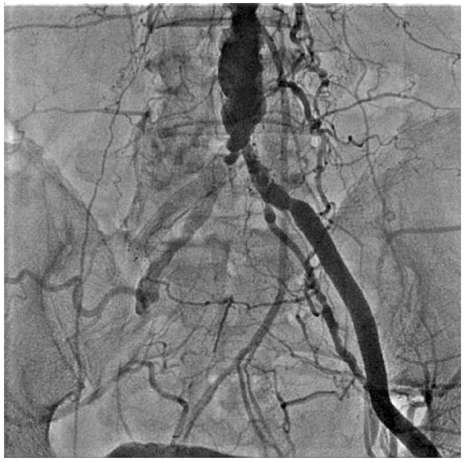Korean Circ J.
2008 Dec;38(12):671-673. 10.4070/kcj.2008.38.12.671.
A Case of Peripheral Revascularization Via the Radial Artery Using Devices Designed for Percutaneous Coronary Intervention
- Affiliations
-
- 1Division of Cardiology, Department of Internal Medicine, Kyungpook National University Medical School, Daegu, Korea. hspark@mail.knu.ac.kr
- 2Division of Cardiology, Department of Internal Medicine, Cheongju Medical Center, Cheongju, Korea.
- KMID: 2225701
- DOI: http://doi.org/10.4070/kcj.2008.38.12.671
Abstract
- This report describes the case of a 68-year-old man who presented with claudication and discoloration of his right lower extremity. He was a 35 pack-year smoker and had diabetes mellitus. The right common iliac artery was shown to be significantly obstructed on an angiogram. One self-expandable stent was deployed at the lesion. Three months later, however, he visited our hospital again due to recurrent claudication. An angiogram revealed in-stent reocclusion of the right common iliac artery. We used a transradial approach and penetrated the lesion with a percutaneous coronary intervention (PCI) guidewire, and dilated the lesion with a PCI balloon. The outcome was favorable.
MeSH Terms
Figure
Reference
-
1. Müller-Leisse C, Janssen R, Hajeck KL, Korsten F, Kippels A, Kamphausen U. Long iliac artery occlusions: feasibility, short- and mid-term outcome. Rofo. 2001. 173:1079–1085.2. Weitz JI, Byrne J, Clagett GP, et al. Diagnosis and treatment of chronic arterial insufficiency of the lower extremities: a critical review. Circulation. 1996. 94:3026–3049.3. Hunink MG, Wong JB, Donaldson MC, Meyerovitz MF, de Vries J, Harrington DP. Revascularization for femoropopliteal disease: a decision and cost-effectiveness analysis. JAMA. 1995. 274:165–171.4. Shim WH, Park SH. Placement of balloon-expandable intraluminal stent in recurrent iliac artery stenosis. Korean Circ J. 1992. 22:500–508.5. Campeau L. Percutaneous radial artery approach for coronary angiography. Cathet Cardiovasc Diagn. 1989. 16:3–7.6. Pancholy SB. Transradial access in an occluded radial artery: new technique. J Invasive Cardiol. 2007. 19:541–544.7. Scheinert D, Braunlich S, Nonnast-Daniel B, et al. Transradial approach for renal artery stenting. Catheter Cardiovasc Interv. 2001. 54:442–447.8. Stanilonae CS, Kurian DC, Coppola JT. Transradial bilateral iliac stenting. J Invasive Cardiol. 2006. 18:E256–E257.9. Kahler J, Koster R, Brockhoff C, et al. Initial experience with a hydrophilic-coated guidewire for recanalization of chronic coronary occlusions. Catheter Cardiovasc Interv. 2000. 49:45–50.
- Full Text Links
- Actions
-
Cited
- CITED
-
- Close
- Share
- Similar articles
-
- Forearm Compartment Syndrome after Transradial Percutaneous Coronary Artery Intervention
- Successful transradial intervention via a radial recurrent artery branch from the radioulnar alpha loop using a sheathless guiding catheter
- Ischemia-guided Revascularization for Stable Ischemic Heart Disease
- Simple Management of Radial Artery Perforation during Transradial Percutaneous Coronary Intervention
- Current Status of Coronary Intervention in Patients with ST-Segment Elevation Myocardial Infarction and Multivessel Coronary Artery Disease





